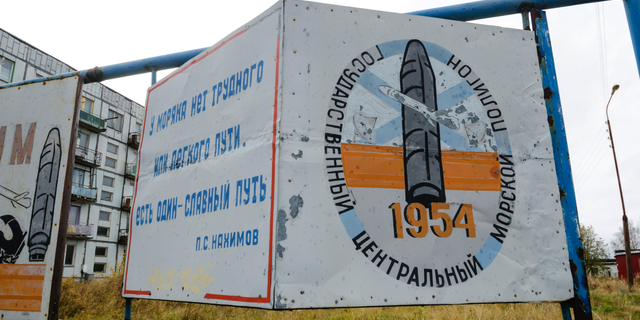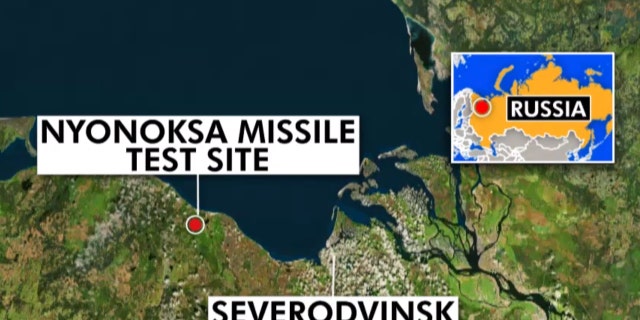Radioactive isotopes have been discovered by Russia’s state weather agency in test samples more than two weeks after a mysterious and deadly explosion earlier this month at a naval weapons testing range in the northwestern part of the country, the agency disclosed Monday.
The Aug. 8 blast took place at a military shooting range in Nyonoksa, in the far northern Arkhangelsk region. Russia’s Defense Ministry initially said the blast killed two people and injured six, but the state-controlled nuclear agency, Rosatom, later disclosed the explosion killed five of its workers and injured three others. Rosatom said the explosion occurred while engineers were testing “a nuclear isotope power source” for a rocket and were thrown into the sea by the explosion.
The mysterious explosion was followed by a brief rise in radiation levels in nearby Severodvinsk, a city of 183,000, but the authorities insisted the recorded levels didn’t pose any danger to local residents. Russia’s state weather agency, Rosgidromet, said earlier this month it believed radiation levels had risen up to 16 times after the accident.
On Monday, Rosgidromet said the brief rise in radiation levels in Severodvinsk was caused by a cloud of radioactive gases that drifted across the area in the wake of the blast.


The cloud of inert radioactive gases formed as a result of a decay of the isotopes, which were identified as Strontium-91, Barium-139, Barium-140, and Lanthanum-140, which have half-lives of 9.3 hours, 83 minutes, 12.8 days and 40 hours respectively, according to Reuters.


The agency said its monitoring has found no trace of radiation in air or ground samples since Aug. 8.
The development came days after the Arkhangelsk regional administration disclosed Friday that 110 medical workers have undergone checks and that one doctor was found with a low amount of radioactive cesium-137 in his muscle tissue. It said the man’s health isn’t in danger and argued that he could have gotten the radioactive isotope through his food.


The statement came after Russian media reports claimed dozens of medical workers were exposed to radiation. The Moscow Times, an independent news outlet, first reported health workers who treated those injured in the blast were not informed about the potential radiation risk from handling the patients. Independent newspaper Novaya Gazeta reported traces of cesium 137 were detected in the emergency room area an hour after the patients were brought in, forcing the area to be decontaminated.
“Doctors and nurses used soap solutions for decontamination. The medical staff had only face masks to protect themselves,” a hospital employee told Novaya Gazeta on the condition of anonymity.
Speculation over advanced Russian cruise missile; Jennifer Griffin has the details.
Russian officials’ changing and contradictory accounts of the incident have drawn comparisons to Soviet attempts to cover up the 1986 explosion and fire at the Chernobyl nuclear power plant in Ukraine, the world’s worst nuclear disaster.
The Russian Defense Ministry at first denied any radiation leak in the incident even as authorities in nearby Severodvinsk reported a brief rise in radiation levels and advised residents to stay indoors and close the windows.
Shifting stories from officials in Moscow follow a deadly explosion at a remote military base. Gen. Jack Keane weighs in on the changing nature of the global nuclear arms race.
President Vladimir Putin has praised the victims, saying they were doing “very important work for the nation’s security,” but kept mum on what type of weapon they were testing. U.S. defense officials and outside observers believe it was a missile Russia calls the 9M730 Burevestnik. The NATO alliance has designated it the SSC-X-9 Skyfall, which was first revealed by Putin in March 2018 along with other doomsday weapons.
Kremlin spokesman Dmitry Peskov on Friday argued that a Chernobyl-style cover-up is undoable now due to fast and multi-sourced information. He also alleged certain unidentified forces could be interested in making false allegations about radioactive threats.


“The situations like the one in Chernobyl are impossible,” he said.
The Comprehensive Nuclear Test Ban Treaty Organization said last week that several Russian radiation monitoring stations went silent shortly after the explosion. Observers interpreted that as part of an effort to conceal the radiation data, which could help determine the technology that was being tested at the time of the explosion.
NORSAR, a Norwegian agency monitoring the nuclear test ban, said Friday its analysis found that there were two separate explosions in the Arkhangelsk region, the second blast coming about two hours after the first one. It reaffirmed that it hasn’t registered any radiation increase.
The Arkhangelsk regional governor, Igor Orlov, rejected the report about the second explosion as “disinformation,” according to the Interfax news agency.
The Associated Press contributed to this report.Travis Fedschun is a reporter for FoxNews.com. Follow him on Twitter @travfed






